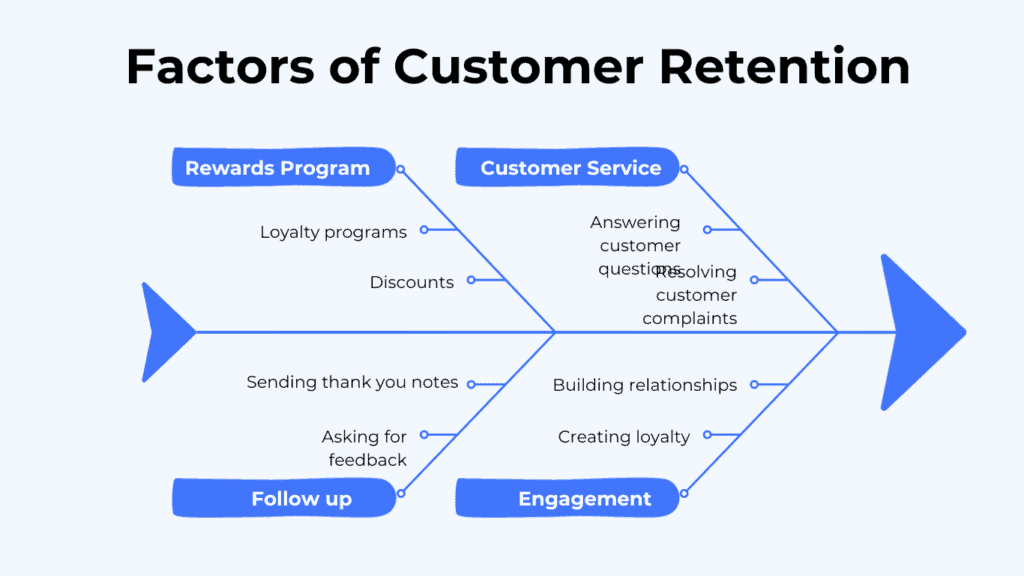1. Customer Churn Rate: The Retention Baseline
In the fast-paced world of financial advising, understanding client retention metrics is crucial. The first metric, Customer Churn Rate, is your baseline. It reveals how well you’re maintaining your client relationships. Imagine it as a health check-up for your client base.
What is Customer Churn Rate?
Customer Churn Rate is the percentage of your clients who leave your services over a specific period. It’s a critical client retention metric. Essentially, it answers, “How many clients am I losing?” But fear not! Understanding churn gives you power—the power to improve, adapt, and retain.
Why is Churn Rate Important?
- Immediate Insight:
- The Pulse of Your Client Base:
- Churn rate is like a pulse check on your client base. A high rate signals an urgent need for strategy changes. It’s about spotting the leaks in your boat and patching them swiftly.
- Future Forecasting:
- Predicting the Tide
- Understanding churn patterns helps you predict future trends. Will next quarter bring calm seas or stormy waters? Churn rate offers a glimpse into what’s ahead.
- Resource Allocation:
- Steering the Ship with Precision
- Knowing your churn rate helps direct your resources effectively. Why pour water into a leaky bucket? Instead, focus on areas that strengthen client retention.
Reducing Churn Rate: A Path to Stability
Reducing churn is about enhancing client satisfaction and loyalty. It’s a commitment to understanding and meeting your clients’ needs. Here’s how you can start:
- Personalized Communication:
- Engage clients with personalized, relevant communication. Make them feel understood and valued. Regular check-ins can turn satisfaction into loyalty.
- Feedback Loops:
- Implement systems for regular client feedback. Understand their concerns and act on them. Clients who feel heard are more likely to stay.
- Quality Services:
- Continuously improve and adapt your services to meet evolving needs. Excellence retains clients. Show them that staying with you means getting the best.
Use Churn Rate as Your Compass of Client Retention Metrics
Understanding your Customer Churn Rate is just the beginning, but it’s a powerful start. It’s your compass in the vast ocean of financial advising. By navigating this metric with care and strategic action, you’re not just avoiding losses; you’re setting the course for a more prosperous, client-filled future. Remember, every client retained is a testament to your service’s value and your commitment to growth. Let churn rate guide you to calmer, more profitable waters.
Remember, “client retention metrics” isn’t just about numbers; it’s about sustaining and growing the trust of those you advise. Embrace it as part of your journey to becoming an indispensable advisor. With every client you keep, you’re building a stronger, more resilient business.
2. Net Promoter Score (NPS): Loyalty at Its Core
In the pursuit of excellence in financial advising, understanding client retention metrics like the Net Promoter Score (NPS) is pivotal. NPS doesn’t just measure satisfaction; it gauges the loyalty and advocacy among your clients. It’s about knowing who would recommend you, a vital sign of your service’s impact.
What is Net Promoter Score within the Client Retention Metrics?
NPS is a client loyalty metric, derived from asking clients one simple question: “On a scale of 0-10, how likely are you to recommend our services to friends or colleagues?” Based on their responses, clients are categorized as Detractors, Passives, or Promoters. Your NPS is the percentage of Promoters minus the percentage of Detractors.
Why Focus on NPS?
- Loyalty Indicator:
- Measuring the Strength of Bonds
- NPS goes beyond satisfaction, digging into the emotional commitment clients feel towards your services. It’s a direct line to understanding client loyalty.
- Referral Potential:
- Harnessing the Power of Word-of-Mouth
- Happy clients are your best advocates. A high NPS means a client base ready to sing your praises, attracting new clients through the most trusted form of marketing: personal recommendations.
- Continuous Improvement:
- Growth Through Feedback
- NPS provides actionable insights. By understanding why clients are detractors or promoters, you can pinpoint areas for improvement or doubling down.
Strategies to Improve NPS
Improving your NPS is synonymous with enhancing client loyalty. Here are some ways to leverage this client retention metric:
- Exceptional Service:
- Provide consistently high-quality advice and personalized service. Clients should feel that you’re indispensable to their financial well-being.
- Engage and Act:
- Regularly engage with your clients and act on their feedback. Show them that their opinions shape your services.
- Build a Community:
- Foster a sense of community among your clients. Exclusive events, forums, or newsletters can make clients feel part of something special, increasing their likelihood to promote your services.
Use NPS as a Beacon of Loyalty of Client Retention Metrics
Net Promoter Score is more than a number; it’s a reflection of the relationships you’ve built and the trust you’ve earned. It’s a beacon guiding you towards deeper client loyalty and a more robust, referral-rich business. Embrace NPS as a core part of your strategy, and watch as your client base becomes a community of advocates, driving growth and stability in your advisory practice.
Remember, in the world of financial advising, loyalty is everything. Your NPS isn’t just a score; it’s a testament to the bonds you’ve forged and the futures you’re helping to build. Keep it at the heart of your retention strategy, and you’ll not only retain clients; you’ll turn them into enthusiastic promoters of your exceptional service.
3. Repeat Purchase Ratio (RPR): Commitment Over Time
In the world of financial advising, client commitment is measured not just in months or years, but in the ongoing choice to continue with your services. That’s where the Repeat Purchase Ratio (RPR) comes in. As a key client retention metric, RPR offers a window into the sustained trust and reliance clients place in your expertise.
Understanding Repeat Purchase Ratio
Repeat Purchase Ratio (RPR) assesses the percentage of clients who return to use your services over time. It’s not about a one-off transaction but the continual choice clients make to stick with your advisory. A high RPR is a sign of long-term commitment and satisfaction.
Why RPR Matters within our Client Retention Metrics?
- Longevity of Relationships:
- Gauging Depth of Trust
- RPR gives you a clear picture of how deep and durable the trust between you and your clients is. It’s a direct measure of the lasting relationships you’re building.
- Predictive Power:
- Forecasting Future Stability
- Understanding your RPR helps predict the future stability of your client base. It indicates the health of your business and potential for growth.
- Service Value:
- Reflecting Quality and Relevance
- A steady or increasing RPR signifies that clients find ongoing value in your services, reaffirming the quality and relevance of your advice.
Improving Your RPR
To enhance your Repeat Purchase Ratio, focus on strategies that deepen client engagement and satisfaction:
- Consistent Quality:
- Deliver unwavering quality in your advice and client service. Ensure every interaction reaffirms the client’s decision to choose you.
- Regular Check-Ins:
- Engage clients regularly with updates, insights, and check-ins that demonstrate your proactive approach and commitment to their success.
- Adapt to Needs:
- Stay attuned to changing client needs and market conditions. Show your ability to adapt and provide relevant, timely advice.
Repeat Purchase Ratio isn’t just a number—it’s a narrative of your business’s success in earning and keeping client trust over time. It’s a testament to the commitment clients have to your service and the role you play in their financial lives. By focusing on strategies to improve RPR, you’re not only boosting a metric but nurturing the very foundations of your client relationships.
In the pursuit of excellence in financial advising, let RPR guide your efforts. It’s a powerful indicator of how well you’re meeting client needs and securing their commitment. Embrace it as a vital sign of your advisory’s health and work continuously to strengthen the bonds that drive your repeat business. Remember, in the journey of financial advising, sustained commitment is the ultimate sign of success.
4. Customer Lifetime Value (CLV): The Long Game
In the realm of financial advising, where relationships and results go hand-in-hand, understanding and maximizing Customer Lifetime Value (CLV) is crucial. CLV isn’t just about the value clients bring today; it’s about their total value over the entire relationship. It’s playing the long game, focusing on enduring profitability and mutual growth.
Understanding Customer Lifetime Value
Customer Lifetime Value (CLV) measures the total worth of a client to your business over the entirety of your relationship. It takes into account not just what clients are worth now, but what they will bring in the future. A high CLV signifies a long, profitable relationship for both parties.
Why Focus on CLV?
- Strategic Investment:
- Investing in Future Returns
- Focusing on CLV encourages you to invest in relationships, understanding that the true payoff comes over time. It’s about cultivating loyalty and depth.
- Resource Allocation:
- Wisely Channeling Efforts
- Knowing the CLV helps you allocate your resources more effectively, focusing on the most profitable relationships and nurturing them to full potential.
- Personalized Services:
- Tailoring for Retention
- Understanding the individual CLV allows for more personalized service. Tailoring your approach to each client maximizes satisfaction and, by extension, value.
Strategies to Enhance CLV
Enhancing Customer Lifetime Value means deepening relationships and continually providing value. Here are some strategies:
- Exceptional Service:
- Consistently deliver advice and service that goes above and beyond. Make each client feel valued and understood, solidifying their loyalty.
- Ongoing Engagement:
- Keep clients engaged with regular updates, insights, and personalized attention. Make your service indispensable to their financial well-being.
- Adaptive Offerings:
- Be responsive to changes in clients’ lives and needs. Offer solutions that grow and adapt with them, ensuring your services are always relevant.
CLV as Your Strategic Compass
Customer Lifetime Value is more than a metric; it’s a philosophy of client relations. It encourages a focus on the long-term payoff of nurturing deep, profitable, and mutually beneficial relationships. By maximizing CLV, you’re committing to a future where both you and your clients thrive together.
Embrace CLV as a core part of your strategy in financial advising. Let it guide your actions and investments, knowing that the true value of your clients unfolds over the journey you share. In the long game of financial advising, understanding and enhancing CLV is your path to enduring success and sustainability.
5. Engagement Rate: Client Retention Metrics in Action
In the realm of client retention metrics, Engagement Rate stands out as a pivotal tool for financial advisors. It’s not just a measure; it’s an actionable insight into how effectively you’re maintaining client interest and interaction. As a critical client retention metric, it directly influences the vitality of your client relationships.
Understanding Engagement Rate
Engagement Rate, a key client retention metric, quantifies the interaction and responsiveness of clients with your services or communications. It’s a gauge of how compelling your brand is to your clientele and a direct reflection of their interest and involvement. As a client retention metric, a robust Engagement Rate indicates a thriving, engaged client base.
Why Engagement Rate is a Crucial Client Retention Metric?
- Reflects Relationship Quality:
- The Pulse of Client Interest
- Engagement rate acts as a real-time indicator of how compelling and valuable clients find your relationship. It’s a pulse check on client interest.
- Informs Content Strategy:
- Crafting Magnetic Content
- Analyzing engagement helps you understand what content resonates most, guiding you to produce more of what your clients love and less of what they don’t.
- Predicts Retention:
- Forecasting Client Loyalty
- Consistently high engagement rates are often precursors to high retention rates. Engaged clients are happy clients, and happy clients stay.
Enhancing Engagement Rate: A Key Client Retention Metric Strategy
To boost your Engagement Rate, focus on making every interaction with clients as impactful and relevant as possible:
- Valuable Content:
- Provide content that is both informative and engaging. Whether it’s market insights or financial planning tips, ensure it’s something clients want to consume and interact with.
- Regular Communication:
- Keep the lines of communication open. Regular newsletters, updates, and check-ins keep clients engaged and remind them of the value you provide.
- Interactive Tools:
- Utilize tools like surveys, polls, or interactive webinars to encourage active participation. Make clients an active part of the conversation.
Harnessing Engagement for Lasting Relationships
In the suite of client retention metrics, Engagement Rate is more than a number—it’s a dynamic indicator of your advisory’s relationship health. By prioritizing this client retention metric, you’re not just keeping tabs on engagement levels; you’re actively working to foster a more involved, committed client base. Let this client retention metric guide you to higher satisfaction, deeper loyalty, and sustained success in your financial advisory practice.



